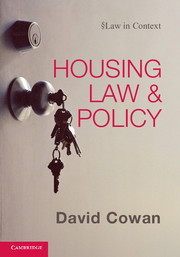Book contents
- Frontmatter
- Contents
- Preface
- List of abbreviations
- Table of legislation
- Table of international instruments
- Table of cases
- 1 Locating housing law and policy
- Part I Regulation of housing tenure
- Part II Access to housing
- 6 Homelessness
- 7 Allocating social housing
- 8 Eligibility
- 9 Access to the private rented sector
- 10 Access to owner-occupation
- Part III Rights and responsibilities
- Postscript
- Bibliography
- Index
10 - Access to owner-occupation
from Part II - Access to housing
Published online by Cambridge University Press: 05 June 2012
- Frontmatter
- Contents
- Preface
- List of abbreviations
- Table of legislation
- Table of international instruments
- Table of cases
- 1 Locating housing law and policy
- Part I Regulation of housing tenure
- Part II Access to housing
- 6 Homelessness
- 7 Allocating social housing
- 8 Eligibility
- 9 Access to the private rented sector
- 10 Access to owner-occupation
- Part III Rights and responsibilities
- Postscript
- Bibliography
- Index
Summary
In this chapter, we look at access to owner-occupation, first focusing on generic issues around access to mortgage finance, and subsequently, more specifically, on access to low-cost ownership (focusing on shared ownership and the RTB). The preface to the discussion in this chapter is contained in Chapter 2, in which the promotion of ‘home ownership’ and the regulation of the mortgage market was discussed. We are at a point in the housing market cycle in which there has been much wringing of hands, consideration given to greater regulation of access to mortgage finance, together with the active promotion of alternatives, sometimes labelled ‘intermediate home ownership’ (IHO). Separately to that cycle, access of sitting tenants to ownership through the RTB, discussed in outline in Chapter 4, has also contracted as a result of various recent statutory limitations. Nevertheless, the apparent virtues of home ownership have remained dominant in policy statements, which continue to promote its benefits. The RTB is also discussed in this chapter in greater detail.
Mortgage finance
For most households, access to ownership is impractical without the aid of some form of financial assistance. This section begins with a general consideration of the regulation of access to mortgage finance, and then drills down to the more specific and limited legislative and judicial controls over that process. There are important links between this section and Chapter 14 below concerning repossession, as inadequate or unchecked assessments by lenders and/or their intermediaries at the outset may be reflected in the types of households against which possession is subsequently sought (see Chapter 2).
- Type
- Chapter
- Information
- Housing Law and Policy , pp. 244 - 260Publisher: Cambridge University PressPrint publication year: 2011



